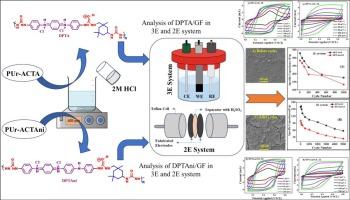具有氧化还原活性苯胺低聚物的酸掺杂聚氨酯在超级电容器中的应用
Q1 Materials Science
引用次数: 0
摘要
在快速发展的现代时代,电子器件的电化学储能材料的进步是一个关键的挑战。在此,我们报道了一种新型氧化还原活性聚氨酯(PUrs)的合成,该聚氨酯具有羰基官能团和从氧化还原活性胺盖三苯胺(ACTA)和胺盖四苯胺(ACTAni)开始的重复氧化还原段。这些材料以2m盐酸掺杂,分别命名为DPTA和DPTAni。采用傅里叶变换红外光谱(FT-IR)、紫外可见吸收光谱(UV-Vis)、场发射扫描电子显微镜(FE-SEM)、x射线衍射(XRD)和布鲁诺尔-埃米特-泰勒(BET)技术对材料的性能和表面分析进行了全面分析。在三电极(3E)系统中,DPTA实现260.9 F/g的高比电容(Csp),优于DPTAni的239 F/g,这是由恒流充放电(GCD)测量确定的。电化学阻抗谱(EIS)证实,在2000次循环时,DPTA和DPTAni的电容保持率分别为59.12%和46.38%,而在5000次循环时,由于溶液电阻的增加,Csp明显下降。这项研究强调了羰基功能化pur作为下一代伪电容性材料的潜力,并进一步优化以提高循环稳定性。本文章由计算机程序翻译,如有差异,请以英文原文为准。

Exploration of acid-doped polyureas with redox-active aniline oligomers for supercapacitor applications
In the rapidly growing modern era, the advancement of electrochemical energy storage (EES) materials for electronic devices is a key challenge. Herein, we report the synthesis of novel redox-active polyureas (PUrs) bearing carbonyl functional group and repeated redox segments starting from the redox-active amine-capped trianiline (ACTA) and amine-capped tetraaniline (ACTAni). These materials are doped with 2 M HCl and designated as DPTA and DPTAni. The material properties and surface analysis are thoroughly analyzed by fourier transform infrared (FT-IR) spectroscopy, UV–Vis absorption spectroscopy, field emission-scanning electron microscopy (FE-SEM), X-ray diffraction (XRD) and Brunauer-Emmett-Teller (BET) techniques. In a three-electrode (3E) system, DPTA achieves a high specific capacitance (Csp) of 260.9 F/g, outperforming DPTAni of 239 F/g, as determined by galvanostatic charge–discharge (GCD) measurements. However, long-term cycling stability exhibits the capacitance retention for DPTA and DPTAni was about 59.12 % and 46.38 %, respectively, for 2000 cycles and with a significant decrement of Csp for 5000 cycles owing to an increase in the solution resistance, as confirmed by Electrochemical impedance spectroscopy (EIS). This study highlights the potential of carbonyl-functionalized PUrs as promising candidates for next-generation pseudo-capacitive materials, with further optimizations for enhancing cycling stability.
求助全文
通过发布文献求助,成功后即可免费获取论文全文。
去求助
来源期刊

Materials Science for Energy Technologies
Materials Science-Materials Science (miscellaneous)
CiteScore
16.50
自引率
0.00%
发文量
41
审稿时长
39 days
 求助内容:
求助内容: 应助结果提醒方式:
应助结果提醒方式:


